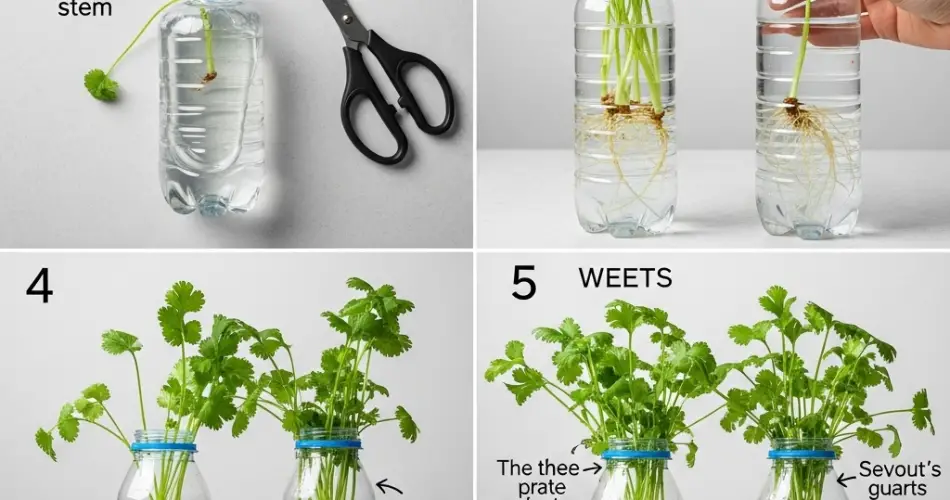Cilantro (also known as coriander) is a popular herb used in cuisines around the world, known for its fresh, citrusy flavor and versatility in both cooking and garnishing. While it’s commonly grown from seeds, regrowing cilantro from cuttings can be a simple, space-saving method that works especially well in limited areas like apartments, balconies, or small backyards.
Using plastic bottles as propagation containers makes the process sustainable and budget-friendly. This method recycles everyday items and allows anyone to create a productive herb garden with very little effort. Here’s a complete guide to help you successfully regrow cilantro from cuttings using plastic bottles.
Why Use Cuttings Instead of Seeds?
Growing cilantro from seeds can take time, and germination isn’t always consistent. Starting from cuttings allows for quicker results and helps maintain the traits of a healthy, established plant. This method is perfect if you already have access to a cilantro plant or fresh cuttings from the market with intact stems.
Materials Needed
To begin your cilantro propagation, gather the following:
-
Fresh cilantro cuttings with at least 4–5 inches of stem
-
One or more clean plastic bottles (1–2 liters)
-
A sharp knife or scissors
-
Water
-
Small container or cup (optional)
-
Potting soil (for transplanting later)
-
Spray bottle (optional)
Step 1: Choose and Prepare Your Cuttings
Select cilantro stems that are green, fresh, and free of disease or damage. The best cuttings are taken from mature plants with firm, healthy stems.
-
Use sharp, clean scissors to cut stems about 4 to 6 inches long.
-
Remove the leaves from the lower part of each stem, leaving only a few at the top.
-
Make a fresh diagonal cut at the base to increase the surface area for water absorption.
If you’re sourcing cilantro from a grocery store, choose bunches with healthy stems and roots if available. Those with the root base still attached can be regrown directly in water.
Step 2: Set Up the Plastic Bottle Container
There are two main methods for using plastic bottles: the water method for root development and the soil method for direct planting.
Water Method:
-
Cut the plastic bottle in half.
-
Fill the bottom part with clean, room-temperature water.
-
Insert the cilantro stems so the leafless portion of the stem is submerged.
-
Place the top half of the bottle (inverted) over the bottom to create a mini greenhouse. Remove the cap for ventilation.
Soil Method (if your cutting has roots or is well-established):
-
Poke small drainage holes in the bottom of a plastic bottle.
-
Cut out a window or the top portion to make planting easier.
-
Fill the bottle with well-draining potting mix.
-
Insert the cutting into the moist soil and gently press it in.
Step 3: Provide the Right Environment
Place your propagation setup in a bright location that receives indirect sunlight. Cilantro prefers cooler temperatures, so avoid placing it in direct afternoon sun or very hot areas.
-
For water propagation: Change the water every two to three days to keep it fresh and oxygenated.
-
For soil propagation: Lightly mist the soil with a spray bottle to keep it moist but not soggy.
Temperatures between 18–24°C (64–75°F) are ideal for root growth.
Step 4: Monitor Root Growth
In about 7–14 days, you should begin to see roots forming if you’re using the water method. Keep the cuttings stable and avoid moving them frequently to encourage healthy root development.
Once the roots are around 1–2 inches long, the cuttings are ready to be transplanted into soil.
Step 5: Transplant into Soil
When your cilantro cuttings have developed strong roots, you can move them to a larger container filled with rich, well-draining soil.
-
Make a small hole in the soil and gently place the rooted cutting inside.
-
Cover the roots with soil and water lightly.
-
Keep the pot in a location with 4–5 hours of morning sun or filtered light.
If you’re using the soil propagation method from the beginning, just continue regular watering and ensure your container has good drainage.
Step 6: Maintain Your Cilantro Plant
Cilantro grows quickly once it takes root. To keep your plant healthy and productive:
-
Water regularly: Keep the soil moist but avoid overwatering.
-
Harvest properly: Begin harvesting leaves once the plant is 6–8 inches tall. Snip off outer leaves first to encourage new growth.
-
Prevent bolting: Cilantro tends to bolt (go to seed) in high heat. Provide partial shade in hot weather and keep the plant cool.
Conclusion
Regrowing cilantro in plastic bottles from cuttings is a smart and eco-conscious way to cultivate fresh herbs at home. Whether you’re working with a balcony, windowsill, or a small backyard space, this method is both efficient and rewarding. With minimal materials and just a bit of care, you’ll have a fresh supply of flavorful cilantro ready for your dishes anytime.



